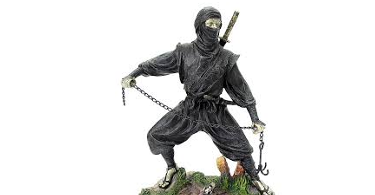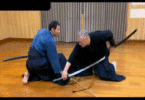Hi everyone how’s your day going? Today’s theme is one of the most popular #Cool Japan”, ”Ninja” (a spy in feudal Japan highly trained in stealth and secrecy), which you might see in the Japanese classic movies.
A big feature of Ninjya is they sometimes disappear with smoke suddenly during the swordfighting or go out of their sight turning somersaults quickly just like Olympic’s gymnasts.
Contents
What’s Ninja ?
In short, a ninja was a covert agent or mercenary in feudal government (around the end of 12th century to the end of 19th century) Japan.
“Ninjas are a unique Japanese martial art using “Ninjutsu” (combat and stealth techniques used by ninja for infiltration, espionage, sabotage, assassination, and guerrilla warfare, etc).

Historically, they were often referred to as “shinobi(stealth)” that describes the various techniques and countermeasures related to espionage and theft during Japan’s Muromachi(1336) and Warring States or belligerent country periods(1467~1615).
During the Warring States period, ninjas were employed by various feudal lords to infiltrate enemy strongholds, gather information while in disguise, conduct night raids, and sometimes engage in sabotage.
However, their most important task was to report on the enemy’s situation to their lord, so they tried to avoid combat as much as possible and survive in order to return to their lord.
This may be why many of the techniques in Ninjutsu are designed for self-defense.”
What do they use to protect themselves?

“Shuriken” Dirk, dart, throwing knife/blade

The secret art of Iga-style ninjutsu
The life of a ninja
When we think of ninjas, we have a strong image of them dressed in black, acting in the dark of night, and using weapons such as shuriken and smoke bombs to fight, but they are not always fighting.
Usually they would pretend to be farmers and do farm work, sometimes they would become mountain priests or peddlers and mingle with the people in the city while conducting espionage activities.
Basically, ninjas avoided fighting and disguised themselves to blend in with the people’s lives and conduct spying activities, collecting information and reporting it to their lords.
They are said to have lived like ordinary farmers and conducted espionage activities and training among them. Collecting advantageous information was an important mission, and they were not always fighting like the ninjas that appear in manga and movies.
Characteristics of the Iga ninjas and the Koga ninjas
Speaking of ninjas, the ninjas of Iga and Koga are very famous, but there were ninjas all over Japan, but among the many ninja groups, the most famous ones are the Iga ninjas and the Koga ninjas.

Ninja Museum
Iga is one of the most famous schools among ninjas. Iga ninjas had many people who excelled in ninjutsu and combat skills, and they contributed to many battles.
Another characteristic of Iga ninjas was that they only contracted with their employers for money and did not build any further relationships.
Iga was close to Kyoto and was able to train ninjas who were familiar with the politics and situation that flowed from Kyoto.
They produced many excellent talents. Many of the people who came from Kyoto, which was the center of politics, were cultured and could read and write characters, which was still rare at that time.
Iga ninjas were good at fire techniques and magic, and among them, the magic called “Kuji Goshinhou” (nine-character protection method) was famous.
Kuji Goshinhou was used for self-protection and warding off evil by making signs with both hands. They were good at using gunpowder for fire techniques.
Iga Ueno Castle
If you want further information on Iga Ueno Castle, click here
On the other hand, Koga-ryu ninjas, who are often said to be enemies or rivals of Iga-ryu, were actually neighbors separated by a mountain, and they were said to have a cooperative relationship because it would not benefit them to be hostile to each other.
One of the characteristics of Koga-ryu is the loose master-servant relationship between the successive lords who ruled Koga’s village as their territory.
Koga ninjas belonged to a community called “So” (general), and everyone who participated in it was said to be equal.
When making decisions as a village, they also decided by majority vote, and they ran their organization in a way that was close to democracy.
This was a big difference from Iga-ryu, where the three upper ninjas had a large say.

In addition, Koga-ryu narrowed down their employers to specific ones. This is said to be derived from the fact that the origin of Koga-ryu ninjas was local samurai who had a clear master-servant relationship with a specific lord.
There were many medicinal herbs growing in Koga, so Koga ninjas were good at using poison for tricks, and in their daily lives they pretended to be medicine sellers and collected information.







